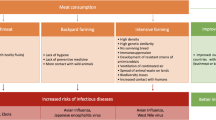Abstract
Over the past ten years, the number of veterinarians in rural areas has declined in many countries, giving rise to concerns about the geographical coverage of livestock health care. However, very little scientific work has been devoted to veterinarian shortage areas. This paper aims to shed light on this issue. Using econometric models based on count data, we test the effect of geographical and socio-economic characteristics of French living zones on the number of new veterinarians established in 2014. This work generated several findings. First, our study emphasises the importance of taking into account the heterogeneity of veterinarians. Indeed, the estimation results highly depend on the type of animals treated and gender. Second, we observed that the location of food animal practitioners depends on the characteristics of local demand (size and type of animal production) as well as on labour supply factors (natural or urban amenities, public service facilities). The results suggest that the risk of veterinarian shortages may be higher for areas specialised in animal production other than bovine (sheep, goats). They also suggest that maintaining public services may be a key issue for attracting food animal veterinarians in remote rural areas. Finally, our results show that veterinarians tend to cluster, which suggests that new veterinarians choose to establish themselves as employees or associates in already existing veterinary offices in order to share costs and minimise risks.


Similar content being viewed by others
Notes
The number of employed practitioners, although increasing, remains low, with only 36% of veterinarians. A majority of them work as independent practitioners, whether by themselves (18%) or as a partner in a practice (46%).
The variances of\( {N}_{{\mathrm{FA}}_i} \), \( {N}_{{\mathrm{M}}_i} \), \( {F}_{{\mathrm{FA}}_i} \) and \( {M}_{{\mathrm{FA}}_i} \) nearly equal their means.
The livestock unit (Unité Gros Bétail in French) is a variable built from coefficients, enabling one to compare the different animals with one another and to sum them up in a single number.
This method used by the French Ministry of Agriculture is based on the calculation of regional coefficients relative to the standard gross output (Orientation technico-économique or OTEX in French).
Base permanente des équipements (BPE)—2012, INSEE [producer], ADISP-CMH [disseminator].
These are travel times by road and in off-peak hours, expressed in minutes, which were calculated using Odomatrix® software (Odomatrix, INRA UMR 1041 CESAER, from IGN Route 500®, RGC®).
The variables Vet 60+ and Vet indep. show non-significant effects in any model. They also exclude, de facto from the regressions, the living zones without veterinarians before 2014 (i.e. 86 observations). Therefore, we decided to remove them from the final regression models. The complete models are presented in the appendices.
We assume that the presence of zero in the first regime of the zero-inflated models relies mainly on the demand for veterinarian services and on the living area’s size. Thus, we have included the two variables livestock and population as covariates z i .
References
Abdel-Rahman, H. M. (1988). Product differentiation, monopolistic competition and city size. Regional Science and Urban Economics, 18(1), 69–86.
Artz, G. M., Kim, Y., & Orazem, P. F. (2016). Does agglomeration matter everywhere?: new firm location decisions in rural and urban markets. Journal of Regional Science, 56(1), 72–95.
Attavanich, W., McCarl, B. A., & Bessler, D. (2011). The effect of H1N1 (swine flu) media coverage on agricultural commodity markets. Applied Economic Perspectives and Policy, 33(2), 241–259.
Bennett, R. (2003). The ‘direct costs’ of livestock disease: the development of a system of models for the analysis of 30 endemic livestock diseases in Great Britain. Journal of Agricultural Economics, 54(1), 55–71.
Boisvert, R. N., Kay, D., & Turvey, C. G. (2012). Macroeconomic costs to large scale disruptions of food production: the case of foot-and-mouth disease in the United States. Economic Modelling, 29(5), 1921–1930.
Bolduc, D., Fortin, B., & Fournier, M.-A. (1996). The effect of incentive policies on the practice location of doctors: a multinomial probit analysis. Journal of Labor Economics, 14(4), 703–732.
Brutel C., Levy D., Floch J-M. (2011). Le nouveau zonage en aires urbaines de 2010. Resource document. INSEE Première. https://www.insee.fr/fr/statistiques/1281191. Accessed Jan 30 2018.
Correia, I., & Veiga, P. (2010). Geographic distribution of physicians in Portugal. The European Journal of Health Economics, 11(4), 383–393.
Deller, S. C., Tsai, T.-H. S., Marcouiller, D. W., & English, D. B. K. (2001). The role of amenities and quality of life in rural economic growth. American Journal of Agricultural Economics, 83(2), 352–365.
Dijkhuizen, A., Renkema, J., & Stelwagen, J. (1991). Modelling to support animal health control. Agricultural Economics, 5(3), 263–277.
Dionne, G., Langlois, A., & Lemire, N. (1987). More on the geographical distribution of physicians. Journal of Health Economics, 6(4), 365–374.
Duranton, G., & Puga, D. (2004). Micro-foundations of urban agglomeration economies. In V. Henderson & J.-F. Thisse (Eds.), Handbook of regional and urban economics (Vol. 4, pp. 2063–2117). North Holland.
Durlauf, S. N. (2004). Neighborhood effects. In V. Henderson & J.-F. Thisse (Eds.), Handbook of regional and urban economics (Vol. 4, pp. 2173–2242). Amsterdam: North Holland.
Faggian, A., & Franklin, R. S. (2014). Human capital redistribution in the USA: the migration of the college-bound. Spatial Economic Analysis, 9(4), 376–395.
Figueiredo, O., Guimaraes, P., & Woodward, D. (2002). Home-field advantage: location decisions of Portuguese entrepreneurs. Journal of Urban Economics, 52(2), 341–361.
Fujita, M., & Thisse, J.-F. (1996). Economics of agglomeration. Journal of the Japanese and International Economies, 10(4), 339–378.
Goetz, S. J., & Debertin, D. L. (1996). Rural-urban locational choices of medical doctors: a county-level analysis. Review of Agricultural Economics, 18(4), 547–563.
Gottlieb, P. D. (1995). Residential amenities, firm location and economic development. Urban Studies, 32(9), 1413–1436.
Graves, P. E. (1980). Migration and climate. Journal of Regional Science, 20(2), 227–237.
Graves, P. E., & Linneman, P. D. (1979). Household migration: theoretical and empirical results. Journal of Urban Economics, 6(3), 383–404.
Greene, W. H. (2008). Econometric analysis (6th ed.). Upper Saddle River: Pearson International Edition.
Henderson, J. V. (1983). Industrial bases and city sizes. The American Economic Review, 73(2), 164–168.
Irwin, E. G., Isserman, A. M., Kilkenny, M., & Partridge, M. D. (2010). A century of research on rural development and regional issues. American Journal of Agricultural Economics, 92(2), 522–553.
Krugman, P. (1991). Increasing returns and economic geography. Journal of Political Economy, 99(3), 483–499.
Krupka, D. J. (2009). Location-specific human capital, location choice and amenity demand. Journal of Regional Sience, 49(5), 833–854.
Lagerkvist, C. J., Hansson, H., Hess, S., & Hoffman, R. (2011). Provision of farm animal welfare: integrating productivity and non-use values. Applied Economic Perspectives and Policy, 33(4), 484–509.
Liviano, D., & Arauzo-Carod, J.-M. (2013). Industrial location and interpretation of zero counts. The Annals of Regional Science, 50(2), 515–534.
Lloyd, T. A., McCorriston, S., Morgan, C. W., & Rayner, A. J. (2006). Food scares, market power and price transmission: the UK BSE crisis. European Review of Agricultural Economics, 33(2), 119–147.
Mangen, M. J., & Burrell, A. (2003). Who gains, who loses? Welfare effects of classical swine fever epidemics in the Netherlands. European Review of Agricultural Economics, 30(2), 125–154.
Mclnerney, J. (1996). Old economics for new problems—livestock disease: presidential address. Journal of Agricultural Economics, 47(1–4), 295–314.
Nakamura, R. (1985). Agglomeration economies in urban manufacturing industries: a case of Japanese cities. Journal of Urban Economics, 17(1), 108–124.
Olfert, M. R., Jelinski, M., Zikos, D., & Campbell, J. (2012). Human capital drift up the urban hierarchy: veterinarians in Western Canada. The Annals of Regional Science, 49(2), 551–570.
Partridge, M. D. (2010). The duelling models: NEG vs amenity migration in explaining US engines of growth. Papers in Regional Science, 89(3), 513–536.
Poudyal, N. C., Hodges, D. G., & Cordell, H. K. (2008). The role of natural resource amenities in attracting retirees: implications for economic growth policy. Ecological Economics, 68(1), 240–248.
Puga, D. (2010). The magnitude and causes of agglomeration economies. Journal of Regional Science, 50(1), 203–219.
Reskin, B., & Campbell, F. L. (1974). Physician distribution across metropolitan areas. American Journal of Sociology, 79(4), 981–998.
Rickman, D. S., & Rickman, S. D. (2011). Population growth in high-amenity nonmetropolitan areas: what’s the prognosis? Journal of Regional Science, 51(5), 863–879.
Smyth, G., East, I., & Wicks, R. (2015). Spatial and temporal evaluation of veterinarians and veterinary employers relative to human and domesticated animal populations in Australia 2002–2012. Australian Veterinary Journal, 93(5), 137–144.
Stimson, R. J., & Minnery, J. (1998). Why people move to the ‘sun-belt’: a case study of long-distance migration to the Gold Coast, Australia. Urban Studies, 35(2), 193–214.
Teillant, A., Brower, C. H., & Laxminarayan, R. (2015). Economics of antibiotic growth promoters in livestock. Annual Review of Resource Economics, 7(1), 349–374.
Vuong, Q. H. (1989). Likelihood ratio tests for model selection and non-nested hypotheses. Econometrica, 57(2), 307–333.
Wang, T., Hennessy, D. A., & O’Connor, A. M. (2012). Where are the food animal veterinarian shortage areas anyway? Preventive Veterinary Medicine, 104(3), 198–206.
Wang, T., Hennessy, D. A., & Park, S. C. (2015). Demand side change, rurality, and gender in the United States veterinarian market, 1990–2010. Agribusiness, 32(2), 236–253.
Ward, A. M., Kamien, M., & Lopez, D. G. (2004). Medical career choice and practice location: early factors predicting course completion, career choice and practice location. Medical Education, 38(3), 239–248.
Winkelmann, R. (2008). Econometric analysis of count data (5th ed.). Heidelberg: Springer-Verlag.
Wooldridge, J. M. (2010). Econometric analysis of cross section and panel data. Cambridge: MIT Press.
Acknowledgements
This work is part of the VeTerra project funded by the European Union, the French State and the Regional Council of Auvergne. The authors are grateful to Jacques Guérin and the National Order of French Veterinarians for providing them with access to the veterinarian database. We would also like to thank Nadia Guiffant for her assistance in the design of the figures and the three anonymous reviewers for their useful comments and suggestions.
Author information
Authors and Affiliations
Corresponding author
Appendix
Appendix
Rights and permissions
About this article
Cite this article
Truchet, S., Mauhe, N. & Herve, M. Veterinarian shortage areas: what determines the location of new graduates?. Rev Agric Food Environ Stud 98, 255–282 (2017). https://doi.org/10.1007/s41130-018-0066-9
Received:
Accepted:
Published:
Issue Date:
DOI: https://doi.org/10.1007/s41130-018-0066-9




